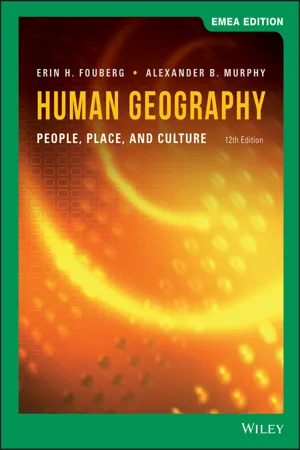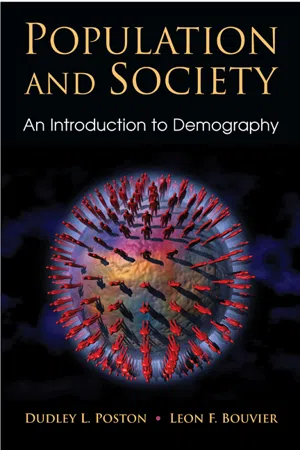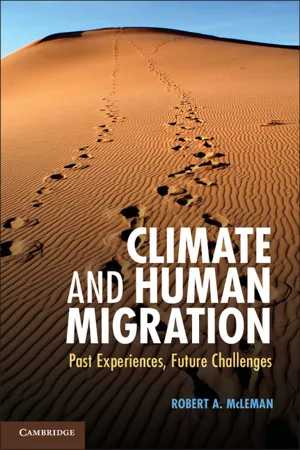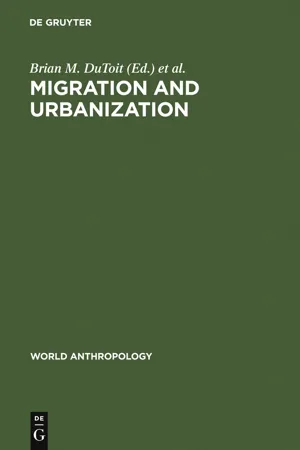Geography
Relocation Diffusion
Relocation diffusion refers to the spread of an idea, innovation, or cultural trait through the physical movement of people from one place to another. This process involves the transfer of the idea or trait to a new location, where it may be adopted and integrated into the local culture. Relocation diffusion can lead to the blending and exchange of different cultural elements across regions.
Written by Perlego with AI-assistance
Related key terms
1 of 5
5 Key excerpts on "Relocation Diffusion"
- eBook - ePub
Migration Theory
Talking across Disciplines
- Caroline B. Brettell, James F. Hollifield, Caroline B. Brettell, James F. Hollifield(Authors)
- 2022(Publication Date)
- Routledge(Publisher)
Exploring Scalar, Spatial, and Placeful Dimensions of Human Mobility Marie PriceDOI: 10.4324/9781003121015-7Geography is a discipline closely associated with maps and spatial reasoning. Maps, especially thematic ones, challenge us to visualize spatial distribution of phenomena across space and over time at various scales. Anything that is unevenly distributed is eminently mappable and thinking in maps invites us to consider spatial arrangements. The varied movement of people has been an irresistible subject for geographical inquiry and theorization since the inception of the modern discipline. Why is a cluster of migrants located in one place and not another? How are clusters linked through networks and how do these distributions influence space and place? What structural or environmental forces are driving human mobility? Mapping forces one to select a scale of analysis; consequently, geographers have a proclivity to shift scales, from the local to the global, and even jump scale when necessary. Not limited to any single container of convenience, such as the territorial state, geographers consider various socio-legal containers when theorizing about migration from neighborhoods, to cities, to meta-regions such as Europe or Africa. Geographic scholarship is increasingly interested in how these containers are enforced, deformed, and reconstituted in response to migration. Finally, geography is concerned with a deeper understanding of context and placemaking, seeing space as layered with information such as: the physical environment, the ethnic composition of residents, and their socioeconomic well-being. Human mobility is often a response to and a catalyst for these layers, and thus the social and environmental contexts of areas of departure and reception invite geographical theorization.This chapter will consider some of the foundational theories that shape geographical understandings of migration and human mobility. It argues that, as a discipline, geography has a long-standing thematic interest in human migration, because the movement of people “continually disrupts and remakes geography, as spatial linkages and interconnections both form and dissolve when people move” (Skop 2019: 108). As international migration has intensified since the 1990s, geographic scholarship that empirically demonstrates these flows and theorizes their impact has steadily increased (Price and Benton-Short 2008; King 2012; Czaika and de Haas 2014; Winders 2014; Yeoh and Ramdas 2014; Ehrkamp 2017, 2019, 2020; Collins 2020). Theoretically, geographers have worked across disciplines, and have modified existing theories, as well as inserted innovative theoretical perspectives and methodological approaches. At the core of much of this work is a profound interest in explaining spatial patterns and human networks, as well as a sensitivity to scalar shifts and bordering practices. Human geographers offer theoretical insights about the migrant experience, limits to human mobility, practices of placemaking, development, and integration, as well as the intersectionality of gender, race, and class in understanding migration (Silvey and Lawson 1999; Carling 2002; van Riemsdijk 2014; Yeoh and Lam 2016). Because of geography’s inclination to examine the relationship between society and environment, there is also a growing research interest in the environmental drivers of migration, especially connected to climate change (Hugo 1996; Piguet 2010; Piguet, Kaenzig, and Guélat 2018; Jockish et al. 2019). - eBook - PDF
Human Geography
People, Place, and Culture
- Erin H. Fouberg, Alexander B. Murphy(Authors)
- 2020(Publication Date)
- Wiley(Publisher)
Migra- tion happens when persons, families, or larger groups leave home and move to a new location with the intent of perma- nently changing where they live. Migrants move a significant distance within a country or across country borders. Migration is the major source of Relocation Diffusion. Migrants take their cultural values and practices with them to their new location, thus making an imprint on the cultural landscape. FIGURE 3.3 Eastern Uganda. Karamoja pastoralists in Uganda rely on their livestock in this region with a short rainy season in April, a longer rainy season in July, and a dry climate the rest of the year. The pastoralists move their livestock to freshwater and vegetation during the long dry season. Alan Gignoux/Alamy Stock Photo 3.1 Explain Migration as a Type of Movement 65 For example, Little Havana in Miami, Florida (Fig. 3.4), has the visible human imprint of generations of Cubans migrat- ing to and living in Dade County, Florida. Even before Cuba became a communist state, 60,000 Cubans lived in the United States, primarily in New York. Between 1959, when Fidel Castro led the Cuban Revolution, and 1961, when Castro made Cuba officially communist, 248,000 Cuban refugees fled to the United States, settling mainly in and around Miami, Florida. T h e U. S . gove r n m e n t l ega l l y allowed Cuban migration because it saw the migrants as refugees escaping a communist government. Cuban migrants arrived and shaped neighborhoods in the greater Miami area (Dade County). Within a generation, Cuban Americans developed businesses, settled in neigh- borhoods, and became a political force in Dade County. In 1973, Dade County officially became bicultural and bilin- gual. Then in 1980, when the Cuban economy crashed, 125,000 Cubans fled to the United States by boat in a six-month period. Cuban Americans in the United States helped organize the refugee flow, hiring boats to trans- port Cubans to the country. - eBook - PDF
Population and Society
An Introduction to Demography
- Dudley L. Poston, Jr., Leon F. Bouvier(Authors)
- 2010(Publication Date)
- Cambridge University Press(Publisher)
The geographic mobility rates in the United States are comparable to those 168 Internal Migration in Canada and Australia, but are much higher than those in many other developed countries like Sweden, Ireland, and Japan. Of course, these latter countries are much smaller geographically than the United States, Canada, and Australia. The next sections of this chapter cover the basic concepts and defini- tions used in analyses of internal migration, followed by a discussion of the main theories of internal migration. We conclude the chapter with three detailed discussions of domestic migration in the United States, of tempo- rary internal migration in China, and of the major migration streams in both countries. CONCEPTS AND DEFINITIONS Over the years, demographers have developed a standard set of concepts and definitions for studying internal migration. The most basic distinction, already mentioned, is between migration and local movement. Local move- ment is the short-distance change of residence within the same community that does not involve crossing a county jurisdictional boundary. Migration is the geographical movement resulting in the permanent change of resi- dence that involves the crossing of a county boundary. Migration differs from local movement in that a migrant leaves his/her community and moves to a new community. Such a move also usually involves other changes: in one’s school, job, church, doctor, dentist, library, pub, shopping center, nightclub, automobile mechanic, and other institutional aspects of daily life. In contrast, with local movement, a permanent change in residence does not involve changing the main institutions in the mover’s daily life. “It is customary to define migration as intercounty mobility” because county units, most of the time, “correspond most nearly to the average size of a community” (Bogue, 1969: 756). - eBook - PDF
Climate and Human Migration
Past Experiences, Future Challenges
- Robert A. McLeman(Author)
- 2013(Publication Date)
- Cambridge University Press(Publisher)
16 2.1 Introduction Scholars in many disciplines pursue migration research from a variety of perspec- tives, each discipline bringing with it a range of favorite theoretical and methodolog- ical tools (Brettell and Hollifeld 2007). No grand unifying theory exists that explains human migration behavior in all its aspects, and there are no signs that one is soon to be developed. There is, however, great complementarity in the various ways scholars have sought to explain migration, each such method making its own useful contri- bution to a broader understanding. In exploring migration in the context of human adaptation to climate, it is useful to first review important explanatory concepts from across disciplines and describe how these can help clarify human migration behavior more generally. The migration process can occur across a range of spatial and temporal scales, and involve many potential actors, institutions, and systems. From the perspective of an individual migrant, the process spans the period from when he or she first con- templates the possibility of moving, through the decision-making process, the act of moving, and on into the period of adjustment at the destination. For some migrants, the process may eventually include a return to the place of origin, or lead to becoming a member of a translocal or transnational community that maintains connections and perpetuates migration between the sending and the receiving area. For migrants who travel short distances and remain within their same cultural community, the migra- tion process may be relatively uncomplicated. For migrants travelling long distances to settle in new and unfamiliar places, migration may be a long and arduous process, with integration into the destination population never completed within the migrant’s own lifetime, but continued by subsequent generations. - eBook - PDF
Migration and Urbanization
Models and Adaptive Strategies
- Brian M. DuToit, Helen I. Safa, Brian M. DuToit, Helen I. Safa(Authors)
- 2011(Publication Date)
- De Gruyter Mouton(Publisher)
This mobility may require a new life style, new attitudes, and new behavioral forms. Just as the migrant has been socialized into his rural life ways, so he now must learn the new social structure of the city (Hanson and Simmons 1968). This PROCESS (Mayer 1970: xviii) of socialization allows the migration of a person to become a mobility process. It allows the researcher then to record behavioral changes in individuals as these persons are trying new roles in adjusting to the changed setting. Most writers who define migra-tion tend to speak only of the physical transition from one geographical area to another. Thus Beijer distinguished between migrations which are based on choice and those which are involuntary (1969:13) but accepts for his definition simply the movement of a person or persons involving a permanent change of residence. Eisenstadt goes one step further in pointing out that this transition usually involves abandoning one social setting and entering another and different one (1955:1). It is infrequently that one finds in the definition a recognition of the fact that such a move is based on a weighing of advantages and disadvantages, and also that the interaction pattern of the migrant changes. For the theme of this discus-sion the following definition will be accepted: Migration is a relatively permanent moving away of a collectivity, called migrants, from one geographical location to another, preceded by decision-making on the part of the migrants on the basis of a hierarchically ordered set of values or valued ends and resulting in changes in the interactional system of the migrants (Mangalam 1968:8). For a long time there has been a tendency to see migration as resulting basically from the weighing of various economic factors (B. Thomas 1954) and the decision to move as being triggered by priority in the push-pull of economics.
Index pages curate the most relevant extracts from our library of academic textbooks. They’ve been created using an in-house natural language model (NLM), each adding context and meaning to key research topics.




